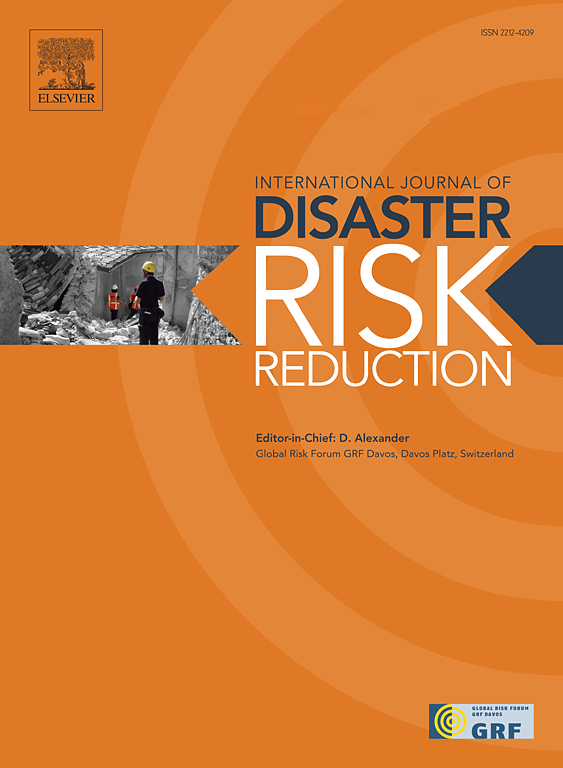Blue-green infrastructure in Jakarta's fringe: An analysis of accessibility to blue-green spaces as a flood solution in Bekasi City
IF 4.2
1区 地球科学
Q1 GEOSCIENCES, MULTIDISCIPLINARY
International journal of disaster risk reduction
Pub Date : 2025-04-15
DOI:10.1016/j.ijdrr.2025.105425
引用次数: 0
Abstract
The increasing threat of urban flooding amidst global climate change, compounded by the complex challenges faced by cities in developing countries, highlights the need to transform urban infrastructure systems. Pressure from rapid population growth in many large cities has led to massive urban sprawl, resulting in intensive land use in the suburbs. An increase in urban capacity has not accompanied this—both in terms of institutions and drainage infrastructure—which can increase vulnerability to flooding. Environmental issues and other socio-economic constraints require sustainable and integrated flood management efforts relying on Blue-Green Infrastructure (BGI). This study seeks to minimize the risk of urban flooding by assessing the population's accessibility to blue-green spaces and formulating several socio-physical parameters to identify priority areas for developing various BGI components. With a case study of Bekasi City, the research reveals how spatial patterns of the relationship between flood hazard, blue-green-gray space, and population density help determine appropriate BGI interventions. The limited accessibility to blue-green space and weak infrastructure integration must be managed with adequate planning to suit local characteristics and solid policy enforcement through integration into existing spatial planning. This also relates to the importance of regional connectivity and collaboration of cities in the Jakarta Metropolitan Area to drive BGI interventions across scales. The study researched in Bekasi City can provide a good basis for insights relevant to developing further research and broader policy enforcement for flood management in metropolitan areas.
雅加达边缘的蓝绿色基础设施:勿加西市作为洪水解决方案的蓝绿色空间可达性分析
在全球气候变化的背景下,城市洪水的威胁日益加剧,再加上发展中国家城市面临的复杂挑战,凸显了改造城市基础设施系统的必要性。许多大城市人口快速增长的压力导致了大规模的城市扩张,导致郊区土地的集约利用。城市容量的增加并没有伴随而来——无论是在制度方面还是在排水基础设施方面——这可能会增加对洪水的脆弱性。环境问题和其他社会经济制约因素需要依靠蓝绿基础设施(BGI)开展可持续和综合的洪水管理工作。本研究旨在通过评估人口对蓝绿空间的可达性,并制定几个社会物理参数来确定开发各种华大基因组件的优先区域,从而最大限度地减少城市洪水的风险。以别卡西市为例,揭示了洪水灾害、蓝绿灰空间和人口密度之间关系的空间格局如何帮助确定适当的华大基因干预措施。蓝绿空间的可达性有限,基础设施整合薄弱,必须通过充分的规划来管理,以适应当地特色,并通过整合现有的空间规划来加强政策的执行。这也涉及到区域连通性和雅加达大都市区各城市合作的重要性,以推动跨规模的华大基因干预。在别加西市进行的研究可以为开展进一步的研究和更广泛的大都市地区洪水管理政策实施提供良好的见解基础。
本文章由计算机程序翻译,如有差异,请以英文原文为准。
求助全文
约1分钟内获得全文
求助全文
来源期刊

International journal of disaster risk reduction
GEOSCIENCES, MULTIDISCIPLINARYMETEOROLOGY-METEOROLOGY & ATMOSPHERIC SCIENCES
CiteScore
8.70
自引率
18.00%
发文量
688
审稿时长
79 days
期刊介绍:
The International Journal of Disaster Risk Reduction (IJDRR) is the journal for researchers, policymakers and practitioners across diverse disciplines: earth sciences and their implications; environmental sciences; engineering; urban studies; geography; and the social sciences. IJDRR publishes fundamental and applied research, critical reviews, policy papers and case studies with a particular focus on multi-disciplinary research that aims to reduce the impact of natural, technological, social and intentional disasters. IJDRR stimulates exchange of ideas and knowledge transfer on disaster research, mitigation, adaptation, prevention and risk reduction at all geographical scales: local, national and international.
Key topics:-
-multifaceted disaster and cascading disasters
-the development of disaster risk reduction strategies and techniques
-discussion and development of effective warning and educational systems for risk management at all levels
-disasters associated with climate change
-vulnerability analysis and vulnerability trends
-emerging risks
-resilience against disasters.
The journal particularly encourages papers that approach risk from a multi-disciplinary perspective.
 求助内容:
求助内容: 应助结果提醒方式:
应助结果提醒方式:


